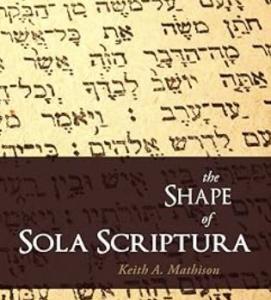In anticipation of my update coming debate in late April, I am reposting this article with updates. Cheer!
The Enthronement of One’s Interpretation
What is sola scriptura? Keith Mathison offers the most comprehensive and widely accepted view of sola scriptura in his book, The Shape of Sola Scriptura (2001). Below, I address his arguments (drawn from Martin Luther and John Calvin) and his attempt to justify his own personal interpretations of the bible. Mathison’s view enthrones the individual and supplants Christ’s Church as the ultimate standard of all Christian doctrines and practices.
Mathison:
…that Scripture was the sole source of revelation; that it was the final authoritative norm of doctrine and practice; that it was to be interpreted in and by the Church; and that it was to be interpreted according to the regula fidei. (The Shape of Sola Scriptura, Keith Mathison, 2001).
The Latin Right Response (from now on as TLR):
The Church interprets the bible, true. The issue is: by whom and how? Historically, scripture was not the final authoritative norm of doctrine and practice. The Church was the final authority.
Mathison:
Since the Word of God is the Word of God, it is what God Himself says, and therefore it is the ultimate authority. The authority of the Word of God is the authority of God Himself, and that authority does not depend upon the assent or verification of anyone or anything, including the Roman church. (Mathison)
TLR Response:
As a book, the bible requires interpretation, and as such requires assent and verification. Since the Church’s founding, biblical interpretation was the preview of those with proper authority through apostolic succession. Apostolic succession was (and is) the regula fidei’s method to safeguard against improper novelty and innovation (see St. Vincent of Lerin’s Commonitory below). Individuals outside of Church, and who lack proper apostolic authority, cannot adequately interpret the bible.
Martin Luther from Mathison’s book:
Unless I am convicted by Scripture and plain reason—I do not accept the authority of popes and councils, for they have contradicted each other—my conscience is captive to the Word of God (Martin Luther, Diet of Worms, 1521).
TLR Response:
Here, Luther inserts himself as the final scriptural interpretive authority. He then goes on to place doubt in the Church by the statement of contradictory authoritative Church councils. However, Luther later pulled back from this position in response to the extreme individualistic “radical reformers” (the Anabaptists) who sought to remake Christianity from scratch. Not to mentioned those “radical reformers” threw Luther’s words at Worms back at him. They too occupied the same authoritative space as Luther, and their consciences were also “captive to the Word of God.” Their theology, like Luther’s, was just as radically individualistic. Luther, faced with utter chaos in Europe, had to appeal the early councils for unity.
Mathison:
They [the Reformers] asserted that Scripture was to be interpreted in and by the Church and that it was to be interpreted according to the ancient apostolic teaching of the Church—the regula fidei. Their complaint arose because the Roman church had completely forsaken the apostolic life and doctrine and had also theologically insulated itself against the possibility of ever being corrected by submitting itself to a higher standard of truth (Mathison).
TLR Response:
Who defines this “higher standard of truth?” By what right can Luther and Calvin (and Protestant in general) hold all Christians to their personal interpretation of Scripture (the “higher standard of truth”)? They cannot. If Luther can declare a conscience held captive to personal interpretation, why not everyone else? In reality, the foundation of sola scriptura justifies mass schism and the continuation of schism in perpetuity, many among Protestants themselves.
The Essence of Sola Scriptura
The intellectual heirs to the Protestant Reformers, the postmodernist, redefined words to reshape the world. Words like “gender” and “racism” are obvious examples. Similarly, their Protestant forbearers redefined words like “faith” and “church” to reshape and reimagine the historic Church. Whereas the historic definition of “church” as “one, holy, catholic, and apostolic,” the new definition morphed into “where the preaching of the gospel is reverently heard, and the sacraments are not neglected” and “the true meaning of Word and sacraments” are cherished” (John Calvin, Institutes of the Christian Religion, IV.i.1).
The Church Redefined
With redefinition the word “church,” the Reformers made their individual and personal interpretation of Scripture the “new” and “true” church authority. They determined for themselves what constituted “the true meaning of Word and sacraments.” What gave John Calvin the authority to hold others to his mere opinion? In reality –nothing and no one. In reality, Calvin had no more authority than the average 16th century Joe with a bible, time, and intelligence to write coherent sentences.
Sola Scriptura: Not Supported Scripturally
Jesus did not command his words written down. He commanded the Apostles to preach and teach to mostly illiterate people, not write to them. The written word came later. The Church decided to write down the events of Jesus’ life. The Good News depends not on the level of one’s education.
Verses Used to Support Sola Scriptura and TLR Response
1 Corinthians 4:6 (do not go beyond what is written)
It is an exegetical stretch to conclude that St. Paul’s reference to “what is written” in 1 Corinthians 4:6 supports sola scriptura. Consider that not even John Calvin thought the verse supported sola scriptura. Calvin considered the phrase “what is written” a “matter of small moment.” He let the readers “take whichever they may prefer…” between his two theories. One, a reference to St. Paul’s own letters or 1 Corinthians itself. Regardless, Calvin DID NOT use this verse to support the doctrine of sola scriptura. Luther is likewise silent on the verse. Moreover, taken as a proof for sola scriptura, this verse contradicts St. Paul in 2 Thessalonians 2:15 when he states, ““stand fast and hold firm to the traditions that you were taught, either by an oral statement or by a letter of ours.”
Matthew 15:1-9 (the primacy of scripture over the “traditions” of men)
First, this passage concerns Jesus’ disagreement with the Pharisees over their hypocritical violation of God’s commandments for the sake of their own traditions (verse 3). Jesus questions their hypocritical interpretations of the Law, not all traditions. Nowhere does he state the bible has primacy over tradition. Also, like 1 Corinthians 4:6, when viewed through the lens of sola scriptura, this verse contracts St. Paul in 2 Thessalonians 2:15. Those who adhere to sola scriptura see Catholic tradition as “traditions of men” and therefore read back into this passage their faulty interpretation.
2 Timothy 3:16-17 (the GO TO bible verses)
The only way to make these verses support sola scriptura is expand the referent of “all Scripture” to include all books in the New Testament, while limit the scope to the 66 books in the Protestant bible. Not only does this verse NOT mean what Protestants think it means, it means more. For example, Paul’s reference to “all Scripture” is at best a reference to the Old Testament. These verses nowhere states implicitly or explicitly that the bible is the sole authority.
Acts 17:11 (the Bereans)
The Bereans had a “noble character.” They examined the scriptures (Old Testament Septuagint) for truth and Luke praised for it. This verse nowhere affirms sola scriptura, only that the Bereans were more “noble” than “those in Thessalonica” who ran Paul out of town. Furthermore, if we follow the example of the Bereans to the letter, sola scriptura becomes limited to the Old Testament alone. In light of sola scriptura, one wonders if the Bereans rejected the Council of Jerusalem’s decision on circumcision… There is no justification in the Old Testament for the Council’s decision.
2 Pet. 3:15-16 (twisted to destruction)
Peter speaks here of the authority of Paul’s letters. He also warns to not distort (misinterpret) Paul’s words, which will lead to destruction. Those who adhere to sola scriptura make themselves the final interpretative authority over that of the Church. With this verse, scripture itself condemns sola scriptura.
The Church Exercised Real Authority
Since the time of the Apostles, the Church exercised real authority concerning doctrine and practice. First witnessed in the book of Acts, the leaders of the Church declared at the Council of Jerusalem circumcision no longer a requirement for gentiles to enter the Church. The Old Testament clearly required this practice in Genesis 17:10–14 as an “everlasting covenant.” The Church exercised its authority over this “everlasting covenant.” The Old Testament taught God would “cut off” any male who broke this covenant. The Apostles, bound to sola scriptura at the Council of Jerusalem, could not authoritatively rule to discontinue the “everlasting covenant” of circumcision. The Church ruled and thus established authority in matters of doctrine and practice.
As with the Council of Jerusalem, the Councils of Nicaea, Ephesus, Constantinople, Chalcedon, etc., the Church exercised its authority, an authority to universally bind others on issues of doctrine and practice. To dissent meant excommunication and anathema. Excommunication and anathema require real authority. Anything less that true authority is merely a stern disagreement of opinion.
The Rule of Faith
The regula fidei foundation is Apostolic Succession. Apostolic succession is the regula fidei’s method to safeguard against improper novelty and innovation. Only those with the proper authority through apostolic succession have the authority to properly interpret Scripture. The Commonitory of St. Vincent clearly states it “necessary that the trend of the interpretation of the prophetic and apostolic writings be directed in accordance with the rule of the ecclesiastical and Catholic meaning.” (Commonitory or For the Antiquity and Universality of the Catholic Faith Against the Profane Novelties of All Heresies, St. Vincent of Lerins, 5th century).
Pragmatic: Sola Scriptura Is Anachronistic
Sola scriptura infers a widespread accessibility to the bible. This belief contradict the history and development of the canon, especially the New Testament canon. Norman Geisler and Ralph MacKenzie state:
As soon as the apostles died, however, it became imperative for the written record of their infallible teaching to be available. And it was—in the apostolic writings known as the New Testament (A Defense of Sola Scriptura, Norman Geisler and Ralph MacKenzie, 2009).
Nowhere in the written record of the early church do we read of this “imperative” response to the Apostles dying off. The organizational process of the New Testament canon took more than 250 years after the death of the last apostle in 100 AD to resemble anything close to the New Testament’s current state. For example, the Thirty-Ninth Festal Letter of Athanasius of Alexandria in 367 AD was the FIRST document that contained the current list.
Inspired Table of Contents
What of the content of the New Testament canon? Of the many works produced in the first 200 years of Christianity, some universally included (the Gospels, Acts, and writings of Paul), others included reluctantly (James, Jude, 2 Peter, 3 John, Hebrews, and the Book of Revelation), and still others rejected (the Didache, the Sheppard of Hermas, Gospel of the Hebrew, and Acts of Paul) (Eusebius Chapter 25). The Apostles left the Church their writings, they did not leave the Church a table of contents. The Church (the authorities in charge) had the task to determine the final canon.
Moreover, scripture contains no list of inspired books either explicitly or implicitly. There exists no biblical justification for the content of the bible. Proponents of sola scriptura rely on the Church to inform them what books belong in the bible. Protestants must go outside of the bible (extra biblical) to tell them what the bible contains.
Language In Translation
Moreover, language adds another layer of inaccessibility to the scriptures. Originally written in Hebrew and Greek, Jerome translated the scriptures into Latin in the late 4th century. This version, known as the Vulgate, was the standard translation of the West for the next millennia. Clearly, Greek and Latin are not common or vernacular languages. The Latin Vulgate was the closest to a common translation in the early in the West. The Latin Vulgate eventually lost this status. The Romance languages (Spanish, France, Italian, and Portuguese) developed after the fall of the Roman Empire in the 5th century and were uniquely separate from each other by the 9th. Moreover, the Germanic languages further divorced itself from Latin than the Romance languages.
Furthermore, a degree of interpretation occurs in the translation process, as well. Decisions made when words have multiple meanings do influence interpretation. A careless translator may produce a mistranslation, and thereby encourage misinterpretation.
For an example, see 1 Peter 3:21
NIV
…and this water symbolizes baptism that now saves you also—not the removal of dirt from the body but the pledge of a clear conscience toward God. It saves you by the resurrection of Jesus Christ…
RSV
Baptism, which corresponds to this, now saves you, not as a removal of dirt from the body but as an appeal to God for a clear conscience, through the resurrection of Jesus Christ…
What of the Common Man?
Most people (including Christians) during the time of the Apostles were illiterate. Illiteracy reigned up to the mid-19th century. Simply put, most Christians were unable to read the bible until around 1850 AD. For most of Church history sola scriptura was a moot point. Like Edmond Dantes in the Count of Monte Cristo, the illiterate relied on the literate for all things that required literacy. Again, apostolic succession safeguarded the transmission of divine truth regardless of the levels of illiteracy.
How Many Bibles Were There to Read?
Firstly, books were scarce and transcribed by hand. This made them very expensive, slow to produce, and therefore rare. Secondly, not even the literate had access to books. Finally, vernacular bibles were not available in mass supply until the late 15th century (thanks to the invention of the printing press). Therefore, it is no coincidence this is the same time sola scriptura took hold in Europe. The two are historically and inseparability connected.
An Authority unto Thyself
Sola scriptura ultimately concerns the justification of one’s personal interpretation of scripture. Sola scriptura allows the individual (or individuals in agreement) to chart their own theological course. Moreover, the bible as a written work requires a reader, an intelligent mind, and a will to act. The reader then assimilates, contemplates, and exegetes the biblical passage to reach theological conclusions.
The bible has no will or a mind. It cannot make judgements or settle arguments. As stated before, the only clear biblical reference to sola scriptura warns against it. In 2 Peter 3:16, Peter warns of ignorant and unstable people who “distort” (misinterpret) St. Paul’s writing (and other scriptures) to their own destruction. Sola scriptura provides the individual believer the authoritative validity of their own theological conclusions. The multitude and magnitude of denominationalism in the world bears witness to this fact.
Sola scriptura enthrones one’s own personal interpretation of the bible and dethrones the proper authority, the Church.
Like what you read? Please check out my other writing here.
Please like and follow me on Facebook.













